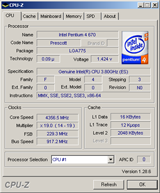Pentium 4 670 3.8GHz Performance Profile
Overclocking and Sandra Quick Take
As we've come to expect from previous overclock outings with new Pentium 4 6XX CPUs, overclocking this new 3.8GHz-rated core proved to be both successful and exciting. Our overclocking efforts were centered around adjusting the FSB of the chip higher, while keeping the core multiplier at its stock 19X setting. We feel this is more indicative of an end-user experience because altering multipliers can get dicey, depending on the motherboard chosen. Having said this, end users do have the option to break down the multiplier of the 670 to a lower multple and raise the FSB even higher than we did in the following experiment.
 |
|



Pentium 4 670 3.8GHz - Overclocked at 4.35GHz - Stock Air Cooled
Once again we were thoroughly impressed and dare we say "amazed" at the available headroom in this new Pentium 4 core. We were able to realize a 917MHz FSB with a stable overall clock speed of 4.35GHz in our test motherboard. Again this was performed at stock voltage, with a stock Intel cooler on an open air test bench. This overclock appeared stable for about half an hour of heavy load under Prime95 testing, and temperatures at the core didn't exceed 63oC. However, we feel it's important to underscore that processors, test systems, and conditions can vary greatly, so these may or may not be indicative of what you could achieve on your own.
|
We began our testing with SiSoftware's SANDRA, the System ANalyzer, Diagnostic and Reporting Assistant. SANDRA consists of a set of information and diagnostic utilities that can provide a host of useful information about your hardware and operating system. We ran four of the built-in subsystem tests that partially comprise the SANDRA 2005 suite (CPU, Multimedia, Cache, and Memory) with the Pentium 4 670 installed into our test rig. All of the scores reported below were taken with the processor and memory running at their respective default clock speeds of 3.8GHz and 667MHz CAS 3, 2, 2, 7 DDR2 Corsair Memory.
 CPU Arithmetic Benchmark Pentium 4 670 (3.8GHz) |
 Multimedia Benchmark Pentium 4 670 (3.8GHz) |
 Memory Benchmark Pentium 4 670 - DDR2-667 |
Sandra's CPU tests report the new 3.8GHz Pentium 4 670 high among its single-core peer group, with performance at the top of its class versus the reference numbers. The same could be said for the results obtained in the Multimedia test, as well. Finally, the SANDRA memory test shows solid performance, but frankly, we've gotten a bit spoiled with the type of bandwidth you can obtain from a system running a 1066MHz FSB. Although we see the memory bandwidth scores here break 5100MB/sec, a 1066MHz FSB-based P4 would put up numbers well into the 6K range with the help of 667MHz DDR2 memory.






